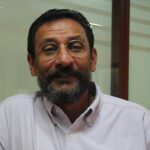The United Nations’ International Day of Education calls for education to be ‘creatively re-imagined’

Today is the United Nations’ International Day of Education (24 January).

Founder & Chairman of the global EdTech – @Cuemath – Manan Khurma, comments:
“The United Nations’ International Day of Education should have everyone focus on global education inequality, and learning losses sustained during the pandemic. We are committed to working towards solving these issues, and agree that education needs a rethink to transform the future.
“Technology plays a crucial role in this journey. We believe that in order for this technology to be more effective, there is a need for more student-teacher interaction. This way, we focus on a personalised learning journey. This not only bridges the education gap, but also ensures student outcomes through fun and intuitive learning.”

Simon Freeman, MD for Education, IRIS Software Group (@IRISSoftwareGrp), comments:
“This International Day of Education calls for education to be creatively re-imagined. We must redefine education’s relationship with technology to ensure digital tools promote inclusion and equality and benefit everyone.
“Solutions need to be targeted at all students, most especially the 258 million children who don’t attend school. Technology has the potential to dramatically expand access to education worldwide, but this will only happen if the public and private sectors join forces and collaborate more closely.
“Teachers and senior leaders are desperate for modern, intuitive, time saving tools. For some time now, the Department of Education has aimed for all schools to have access to a modern broadband infrastructure to support schools’ much-needed move to the cloud. In order to become more agile and future-proof, schools and Trusts need to migrate IT infrastructure to a cloud-based environment where information can be stored safely and accessed from anywhere in real-time.
“Teachers and school leaders need accurate, real-time intelligence in their hands so they can make informed decisions that improve the life chances of students. However, a staggering 90% of school leaders report data and analysis is a significant issue impacting their workload; clearly, more creative solutions are needed. Real-time data can help teachers connect the dots around pupils, ensuring they can uniquely cater to their needs and make interventions count. Cloud software connects this information, bringing individual stories to life across absence, behaviour, wellbeing, safeguarding, attainment and progression.
“In all of these areas, we have only just begun to scratch the surface of what is possible. By implementing the right EdTech, schools can move in an agile way to mitigate constantly changing situations and provide long-term stability for teachers, school leaders, students and parents.”

Dr Anantha Duraiappah, Director at UNESCO’s Mahatma Gandhi Institute of Education for Peace and Sustainable Development (MGIEP), comments:
“When reimagining our education systems, we must start out with the fundamental question: what kind of education is needed and for what kind of society in the future?
“Preliminary results from the International Science and Evidence-based Education (ISEE) Assessment – a two year initiative by the UNESCO category one Mahatma Gandhi Institute of Education for Peace and Sustainable Development (MGIEP), including over 260 scientists and experts from over 45 countries, and covering more than 10 disciplines to be launched in March 2022 – suggest that an education system designed for human flourishing will lead to better training opportunities for jobs that offer a sense of joy, contribution to society, and fulfilment.
“These findings suggest that any educational system in the future should align curricula, teaching practices and learning evaluations with a ‘whole brain’ notion of neural interconnectedness and combined cognitive, social and emotional learning. A worthy call but the herculean challenge now is to find answers as to how this aspiration is achieved. How is the blueprint for implementation created?
“A key point that has emerged from the ongoing global problems presented by climate change and the COVID-19 pandemic is the importance of rigorous peer reviewed science and evidence for policy making. This also applies to education. Policy not grounded in science and evidence is likely to perpetuate existing insufficient education systems.
“Going forward, let’s chart an educational blueprint for present and future generations of learners that is based on evidence-based science and not reliant on anecdotal data and information.”
Countries do not expect to achieve 2030 global education targets
World Education Day: A new report released today by UNESCO’s Institute for Statistics and the Global Education Monitoring Report finds that, according to their own benchmarks, countries will not achieve Sustainable Development Goal 4 (SDG 4) of ensuring inclusive and equitable quality education and lifelong learning opportunities for all by 2030.
This is a wakeup call for the world’s leaders as millions of children will continue to miss out on school and high-quality learning.
The report, National SDG 4 benchmarks: fulfilling our commitments, compiles the findings from the culmination of a two-year global process convened by UNESCO.
Participating countries identified their targets for 2025 and 2030 relative to six key SDG 4 indicators on:
- early childhood education attendance;
- school attendance;
- completion;
- minimum proficiency in reading and mathematics;
- trained teachers; and
- public education expenditure.
The commitment made was to accelerate progress between now and the deadline relative to the rate countries achieved from 2000-2015. The findings show that even if countries reach their benchmarks, the world will still fall short of the ambition set out in SDG 4. This is even before taking into account the potential consequences of COVID-19 on education development.
“It is a real step forward that some two-thirds of countries are realistically assessing their chances of achieving the SDG 4 goals. It is critical that nations hold themselves accountable to their commitments for their children. However, almost halfway to our deadline, the process has shown that, even by their own assessment, most countries are not expected to get close to the 2030 goal,” said Silvia Montoya, Director of the UNESCO Institute for Statistics.
“The next step must be to encourage all countries to submit benchmarks and determine which policies to prioritise before 2030.”
The report shows that according to their own measures, Latin America and the Caribbean and Central and Southern Asia are on course to achieve universal early childhood education. Sub-Saharan Africa, North Africa and Western Asia will not achieve this goal, where it is estimated that roughly two in three children will be enrolled in early childhood education by 2030 (up from less than half currently).
According to their plans, all regions will meet or be very close to achieving universal primary education. Challenges will remain in sub-Saharan Africa where 8% of children of primary school age are still predicted to be out of school in 2030 (down from 19% currently).
By 2030, countries in sub-Saharan Africa expect to be able to achieve a reduction in the rate of out-of-school upper secondary age youth from 47% to 32%; those in Central and Southern Asia expect to reduce their rate from 32% to 17%. In North Africa and Western Asia, the benchmarks show that countries believe they can reduce the rate from 28% to 14% and from 19% to 11% in Latin America and the Caribbean. The process has delivered a reality check with regards to the goal of universal completion of secondary education by 2030, which no region is on track to achieve. Completion rates are expected to land at 89% at lower secondary and 72% at the upper secondary level by the deadline.
Countries are the least confident about the ability to accelerate progress in mathematics skills: by 2030, globally, benchmarks show that an expected 26% will still not be able to do basic mathematics in the early grades, 32% at the end of primary and 34% at the end of lower secondary.
The percentage of trained teachers is expected to increase between 2015 and 2030 to over 90% in each level of education. The fastest growth is expected at the pre-primary education level, from 70% to 94%. Still, by the deadline, countries in sub-Saharan Africa expect that, despite their best efforts, over a quarter of teachers at the pre-primary level will remain untrained.
“These nationally determined targets do not yet take into account the possible impact of COVID-19 on education which we know has significantly slowed down and may have even rolled back progress on education. It is also troubling that a fifth of countries do not have plans with targets, so there is still work to do before a full realistic picture of where we aim to be by 2030 is available,” added Manos Antoninis, Director of the Global Education Monitoring Report.
The current benchmarks will be reviewed in 2022 to see if countries deem a significant revision of expectations as a result of COVID-19 school closures is necessary.
This work answers a call by the UN Secretary General in his Synthesis Report in 2014 on countries to do ‘benchmarking for progress’ and follows the Education 2030 Framework for Action that called on countries to establish ‘appropriate intermediate benchmarks … for addressing the accountability deficit associated with longer-term targets’.
About UNESCO’s GEM Report
The Global Education Monitoring Report (GEM Report) is developed by an independent team and published by UNESCO. It has the official mandate of monitoring progress in meeting the Sustainable Development Goal on education, SDG 4.











Responses